Boswellia sacra
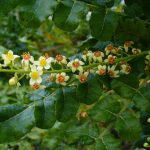 Boswellia sacra (commonly known as frankincense or olibanum-tree) is a tree in the Burseraceae family, from which frankincense, a resinous dried sap, is harvested. It is native to the Arabian Peninsula (Oman, Yemen) , and northeastern Africa (Somalia). Read more
Boswellia sacra (commonly known as frankincense or olibanum-tree) is a tree in the Burseraceae family, from which frankincense, a resinous dried sap, is harvested. It is native to the Arabian Peninsula (Oman, Yemen) , and northeastern Africa (Somalia). Read more
Cedrus deodara
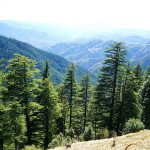 Cedrus deodara (deodar cedar, Himalayan cedar) is a species of cedarnative to the western Himalayas in eastern Afghanistan, northern Pakistan and northern India, in Tibet and western Nepal, occurring at 1,500–3,200 m (4,921–10,499 ft) altitude.Read more
Cedrus deodara (deodar cedar, Himalayan cedar) is a species of cedarnative to the western Himalayas in eastern Afghanistan, northern Pakistan and northern India, in Tibet and western Nepal, occurring at 1,500–3,200 m (4,921–10,499 ft) altitude.Read more
Cupressus sempervirens (cypress)
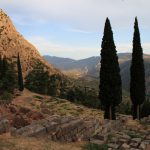 Cupressus sempervirens, the Mediterranean cypress (also known as Italian cypress, Tuscan cypress, graveyard cypress, or pencil pine), is a species cypress native to the eastern Mediterranean region, in Libya, Albania, Croatia, Greece, Turkey, Cyprus, Egypt, Syria, Lebanon, Israel, Malta, Italy, Jordan and Iran.
Cupressus sempervirens, the Mediterranean cypress (also known as Italian cypress, Tuscan cypress, graveyard cypress, or pencil pine), is a species cypress native to the eastern Mediterranean region, in Libya, Albania, Croatia, Greece, Turkey, Cyprus, Egypt, Syria, Lebanon, Israel, Malta, Italy, Jordan and Iran.
Elemi
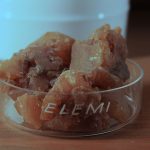 Elemi - Canarium is a genus of about 100 species of tropical and subtropical trees, in the family Burseraceae. They grow naturally across tropical Africa, south and southeast Asia, Indochina, Malesia, Australia and western Pacific Islands; including from southern Nigeria east to Madagascar, Mauritius, Sri Lanka and India;Read more
Elemi - Canarium is a genus of about 100 species of tropical and subtropical trees, in the family Burseraceae. They grow naturally across tropical Africa, south and southeast Asia, Indochina, Malesia, Australia and western Pacific Islands; including from southern Nigeria east to Madagascar, Mauritius, Sri Lanka and India;Read more
Galbanum
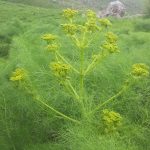 Galbanum is an aromatic gum resin and a product of certain umbelliferous Persian plant species in the genus Ferula, chiefly Ferula gummosa (synonym F. galbaniflua) and Ferula rubricaulis. Galbanum-yielding plants grow plentifully on the slopes of the mountain ranges of northern Iran. Read more
Galbanum is an aromatic gum resin and a product of certain umbelliferous Persian plant species in the genus Ferula, chiefly Ferula gummosa (synonym F. galbaniflua) and Ferula rubricaulis. Galbanum-yielding plants grow plentifully on the slopes of the mountain ranges of northern Iran. Read more
Grapefruit (Citrus paradisi)
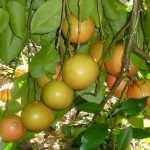 The grapefruit (Citrus × paradisi) is a subtropical citrus tree known for its relatively large sour to semi-sweet, somewhat bitter fruit. Grapefruit is a citrus hybrid originating in Barbados as an accidental cross between two introduced species – sweet orange (C. sinensis), and pomelo (or shaddock) (C. maxima) – both of which were introduced from Asia in the seventeenth century.Read more
The grapefruit (Citrus × paradisi) is a subtropical citrus tree known for its relatively large sour to semi-sweet, somewhat bitter fruit. Grapefruit is a citrus hybrid originating in Barbados as an accidental cross between two introduced species – sweet orange (C. sinensis), and pomelo (or shaddock) (C. maxima) – both of which were introduced from Asia in the seventeenth century.Read more
Guaiacum
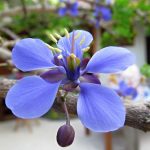 Guaiacum denotes a genus of the zygomatic family (Zygophyllaceae). It contains six to eight tree species from tropical and subtropical America. Guaiacum species are trees or shrubs with very hard, resin-rich wood. There are six to eight species in the genus of guaiac trees (Guaiacum) in tropical and warmer America: Guaiacum angustifolium - Mexico and Texas; Guaiacum coulteri - Mexico; Guaiacum unijungum - Baja California in Mexico; Guaiacum officinale L. - Antilles and the north coast of South America.Read more
Guaiacum denotes a genus of the zygomatic family (Zygophyllaceae). It contains six to eight tree species from tropical and subtropical America. Guaiacum species are trees or shrubs with very hard, resin-rich wood. There are six to eight species in the genus of guaiac trees (Guaiacum) in tropical and warmer America: Guaiacum angustifolium - Mexico and Texas; Guaiacum coulteri - Mexico; Guaiacum unijungum - Baja California in Mexico; Guaiacum officinale L. - Antilles and the north coast of South America.Read more
Juniperus communis
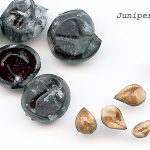 Juniperus communis is a species in the genus Juniperus, in the family Cupressaceae. It has the largest range of any woody plant, throughout the cool temperate Northern Hemisphere from the Arctic south in mountains to around 30°N latitude in North America, Europe and Asia. Read more
Juniperus communis is a species in the genus Juniperus, in the family Cupressaceae. It has the largest range of any woody plant, throughout the cool temperate Northern Hemisphere from the Arctic south in mountains to around 30°N latitude in North America, Europe and Asia. Read more
Labdanum
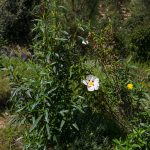 Labdanum, also called ladanum, laudanum, ladan or ladanon, is a sticky brown resin obtained from the shrubs Cistus ladanifer (western Mediterranean) and Cistus creticus (eastern Mediterranean), species of rockrose. It has a long history of use in herbal medicine and as a perfume ingredient.Read more
Labdanum, also called ladanum, laudanum, ladan or ladanon, is a sticky brown resin obtained from the shrubs Cistus ladanifer (western Mediterranean) and Cistus creticus (eastern Mediterranean), species of rockrose. It has a long history of use in herbal medicine and as a perfume ingredient.Read more
Laurus nobilis
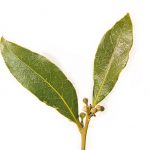 Laurus nobilis or laurel is an aromatic evergreen with green, glossy leaves, native to the Mediterranean region. Laurel can vary greatly in size and height, sometimes reaching 10 to 18 metres. It is widely used in a wide variety of recipes, particularly in the Mediterranean kitchen, and for medical treatments. In ancient Greece (Daphne is the Greek name for the tree) and Roman culture it was a symbol of victory and highest status, today it gives still the name to an academical degree. In the Bible laurel is often an emblem of prosperity and fame, in Christian tradition, it symbolizes the resurrection of Christ.Read more
Laurus nobilis or laurel is an aromatic evergreen with green, glossy leaves, native to the Mediterranean region. Laurel can vary greatly in size and height, sometimes reaching 10 to 18 metres. It is widely used in a wide variety of recipes, particularly in the Mediterranean kitchen, and for medical treatments. In ancient Greece (Daphne is the Greek name for the tree) and Roman culture it was a symbol of victory and highest status, today it gives still the name to an academical degree. In the Bible laurel is often an emblem of prosperity and fame, in Christian tradition, it symbolizes the resurrection of Christ.Read more
Lavandula
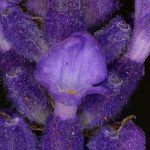 Lavandula (common name lavender) is a genus of 39 known species of flowering plants in the mint family, Lamiaceae. It is native to the Old World and is found from Capo Verde and the Canary Islands, Europe across to northern and eastern Africa, the Mediterranean, southwest Asia to southeast India. Many members of the genus are cultivated extensively in temperate climates as ornamental plants and landscape use, for use as culinary herbs, and also commercially for the extraction of essential oil. The English word lavender is generally thought to be derived from Old French lavandre, ultimately from the Latin lavare (to wash), referring to the use of infusions of the plants. The most common form in cultivation is the common or English lavender Lavandula angustifolia. Lavenders flourish best in dry, well-drained, sandy or gravelly soils in full sun. All types need little or no fertilizer and good air circulation. English lavender yields an essential oil with sweet overtones, and can be used in balms, salves, prfumes, cosmetics, and topical applications. The plant is as well used as a condiment in the kitchen and as a herb in medical treatments having an anxiolytic effect and influence in sleep quality. Lavender was one of the holy herbs used in the biblical Temple to prepare the holy essence, and nard (‘nerd’ in Hebrew) is mentioned in the Song of Solomon (4,14).
Lavandula (common name lavender) is a genus of 39 known species of flowering plants in the mint family, Lamiaceae. It is native to the Old World and is found from Capo Verde and the Canary Islands, Europe across to northern and eastern Africa, the Mediterranean, southwest Asia to southeast India. Many members of the genus are cultivated extensively in temperate climates as ornamental plants and landscape use, for use as culinary herbs, and also commercially for the extraction of essential oil. The English word lavender is generally thought to be derived from Old French lavandre, ultimately from the Latin lavare (to wash), referring to the use of infusions of the plants. The most common form in cultivation is the common or English lavender Lavandula angustifolia. Lavenders flourish best in dry, well-drained, sandy or gravelly soils in full sun. All types need little or no fertilizer and good air circulation. English lavender yields an essential oil with sweet overtones, and can be used in balms, salves, prfumes, cosmetics, and topical applications. The plant is as well used as a condiment in the kitchen and as a herb in medical treatments having an anxiolytic effect and influence in sleep quality. Lavender was one of the holy herbs used in the biblical Temple to prepare the holy essence, and nard (‘nerd’ in Hebrew) is mentioned in the Song of Solomon (4,14).
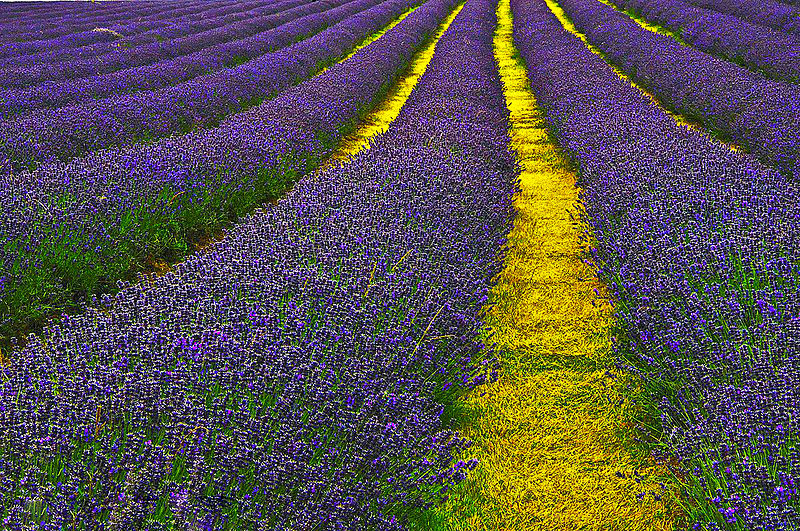
Lavandula Angustifolia, der Echte Lavendel oder Schmalblättrige Lavendel (Lavandula officinalis, Lavandula vera) ist eine Pflanzenart aus der Gattung Lavendel (Lavandula) innerhalb der Familie der Lippenblütler (Lamiaceae). Der mittellateinische Name "Lavandula" gehört zum lateinischen lavare = waschen, weil man das aromatische Kraut gern dem Waschwasser oder den Bädern zusetzte. Lavendel ist ein Lehnwort aus dem lateinischen "lavandula". Die Heimat des Lavendel sind ursprünglich die Küstenregionen des Mittelmeers. Dort kommt er an trockenen, warmen Hängen bis Dalmatien und Griechenland sowie in der Toskana in Italien weit verbreitet vor. Benediktiner-Mönche führten ihn nördlich der Alpen ein. Der Echte Lavendel gehört zu denjenigen Arten, die als winterhart gelten und daher im Freien den in Mitteleuropa üblichen Winter gut überstehen. Eingebürgert ist er bei Jena, Rudolstadt und Bad Blankenburg. Aktuell wird in Deutschland ein bescheidener Lavendelanbau in der Nähe von Detmold betrieben. Der Gebrauch des Lavendels auf den britischen Inseln geht weit zurück, denn er ist schon unter den Arzneien der Physicians of Myddvai (13. Jahrhundert) angeführt. Allerdings gilt: je kälter die Gegend, desto geruchsärmer der Lavendel. Dem Echten Lavendel wird ein breites therapeutisches Spektrum zugeschrieben. In seinem Lehrbuch der Biologischen Heilmittel (1938) sagt Gerhard Madaus: „Lavandula ist ein mildes Nervinum, das besonders bei Migräne gern gegeben wird. Man verordnet es bei Neurasthenie, Vertigo, nervösem Herzklopfen, allgemeinen nervösen Aufregungszuständen, Hysterie, Krämpfen, Ohnmachten und Schlaflosigkeit.“ Matthiolus nennt in seinem Kräuterbuch die Lavandula ein "köstlich Kraut wider alle kalten Gebresten des Hirns und der Senader/ als da ist der Schwindel/ gantze und halbe Schlag/ der fallend Siechtag/ die Schlafsucht/ Krampff/ Zittern/ Contract und Lähme".
https://vimeo.com/190195097
Oud
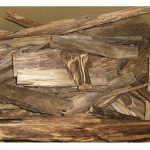 Oud, also known as agarwood, aloewood or jinko, is a resin that forms in Aquilaria trees, large evergreens native to southeast Asia when they become infected with a type of mould. Prior to infection, the heartwood is relatively light and pale coloured; however, as the infection progresses, the tree produces a dark aromatic resin in response to the attack, which results in a very dense, dark, resin embedded heartwood. Read more
Oud, also known as agarwood, aloewood or jinko, is a resin that forms in Aquilaria trees, large evergreens native to southeast Asia when they become infected with a type of mould. Prior to infection, the heartwood is relatively light and pale coloured; however, as the infection progresses, the tree produces a dark aromatic resin in response to the attack, which results in a very dense, dark, resin embedded heartwood. Read more
Palo Santo
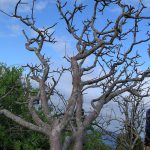 Bursera graveolens, known in Spanish as palo santo ("holy wood"), is a wild tree native from Mexico and the Yucatán Peninsula to Peru and Venezuela that inhabits the South American Gran Chaco region (northern Argentina, Paraguay, Bolivia and the Brazilian Mato Grosso). It is also found in Costa Rica, El Salvador, Guatemala, Honduras, Colombia, Ecuador, Peru and on the Galápagos Islands. Read more
Bursera graveolens, known in Spanish as palo santo ("holy wood"), is a wild tree native from Mexico and the Yucatán Peninsula to Peru and Venezuela that inhabits the South American Gran Chaco region (northern Argentina, Paraguay, Bolivia and the Brazilian Mato Grosso). It is also found in Costa Rica, El Salvador, Guatemala, Honduras, Colombia, Ecuador, Peru and on the Galápagos Islands. Read more
Salvia apiana (White sage)
 Salvia apiana (white sage, bee sage, or sacred sage) is an evergreen perennial shrub that is native to the southwestern United States and northwestern Mexico, found mainly in the coastal sage scrub habitat of Southern California and Baja California, on the western edges of the Mojave and Sonoran deserts. S. apiana is a shrub that reaches 1.3 to 1.5 metres tall and 1.3 metres wide. The whitish evergreen leaves have oils and resins that release a strong aroma when rubbed. Read more
Salvia apiana (white sage, bee sage, or sacred sage) is an evergreen perennial shrub that is native to the southwestern United States and northwestern Mexico, found mainly in the coastal sage scrub habitat of Southern California and Baja California, on the western edges of the Mojave and Sonoran deserts. S. apiana is a shrub that reaches 1.3 to 1.5 metres tall and 1.3 metres wide. The whitish evergreen leaves have oils and resins that release a strong aroma when rubbed. Read more

 Deutsch
Deutsch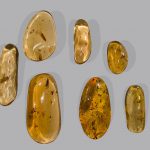 Copal is a name given to tree resin from the copal tree Protium copal (Burseraceae) that is particularly identified with the aromatic resins used by the cultures of pre-Columbian Mesoamerica as ceremonially burned incense and other purposes.
Copal is a name given to tree resin from the copal tree Protium copal (Burseraceae) that is particularly identified with the aromatic resins used by the cultures of pre-Columbian Mesoamerica as ceremonially burned incense and other purposes.